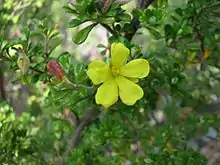Hibbertia hermanniifolia
Hibbertia hermanniifolia, commonly known as outcrop guinea-flower, is a shrub that is native to eastern Australia. It grows to 150 cm high and has spathulate, cuneate or oblanceolate leaves between 5 and 30 mm long. Yellow flowers with five petals appear from spring to early autumn.[1]
| Hibbertia hermanniifolia | |
|---|---|
 | |
| subspecies recondita in flower at Mount Elizabeth | |
| Scientific classification | |
| Kingdom: | Plantae |
| Clade: | Tracheophytes |
| Clade: | Angiosperms |
| Clade: | Eudicots |
| Order: | Dilleniales |
| Family: | Dilleniaceae |
| Genus: | Hibbertia |
| Species: | H. hermanniifolia |
| Binomial name | |
| Hibbertia hermanniifolia | |
The species was formally described in 1817 by Swiss botanist Augustin Pyramus de Candolle.[2] There are two recognised subspecies:
- H. hermanniifolia DC. subsp. hermanniifolia (New South Wales)
- H. hermanniifolia subsp. recondita Toelken (New South Wales and Victoria, type: Mount Elizabeth No 2, Victoria)[3]
See also
References
- "Hibbertia hermanniifolia ". PlantNET - New South Wales Flora Online. Royal Botanic Gardens & Domain Trust, Sydney Australia. Retrieved 30 December 2013.
- "Hibbertia hermanniifolia ". Australian Plant Name Index (APNI), IBIS database. Centre for Plant Biodiversity Research, Australian Government, Canberra. Retrieved 30 December 2013.
- Toelken, H.R. (2012). "Notes on Hibbertia (Dilleniaceae) 7. H. hermanniifolia group(subgen. Hemistemma) from mainly temperate eastern Australia". Journal of the Adelaide Botanic Gardens. 25: 55–70.
This article is issued from Wikipedia. The text is licensed under Creative Commons - Attribution - Sharealike. Additional terms may apply for the media files.